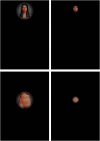Mapping female bodily features of attractiveness
- PMID: 26791105
- PMCID: PMC4726249
- DOI: 10.1038/srep18551
Mapping female bodily features of attractiveness
Abstract
"Beauty is bought by judgment of the eye" (Shakespeare, Love's Labour's Lost), but the bodily features governing this critical biological choice are still debated. Eye movement studies have demonstrated that males sample coarse body regions expanding from the face, the breasts and the midriff, while making female attractiveness judgements with natural vision. However, the visual system ubiquitously extracts diagnostic extra-foveal information in natural conditions, thus the visual information actually used by men is still unknown. We thus used a parametric gaze-contingent design while males rated attractiveness of female front- and back-view bodies. Males used extra-foveal information when available. Critically, when bodily features were only visible through restricted apertures, fixations strongly shifted to the hips, to potentially extract hip-width and curvature, then the breast and face. Our hierarchical mapping suggests that the visual system primary uses hip information to compute the waist-to-hip ratio and the body mass index, the crucial factors in determining sexual attractiveness and mate selection.
Figures




Similar articles
-
Eye-tracking of men's preferences for waist-to-hip ratio and breast size of women.Arch Sex Behav. 2011 Feb;40(1):43-50. doi: 10.1007/s10508-009-9523-5. Epub 2009 Aug 18. Arch Sex Behav. 2011. PMID: 19688590
-
Back view of beauty: a bias in attractiveness judgment.Perception. 2013;42(1):95-102. doi: 10.1068/p7356. Perception. 2013. PMID: 23678619 Clinical Trial.
-
Female and male perceptions of female physical attractiveness in front-view and profile.Br J Psychol. 2001 May;92(Pt 2):391-402. Br J Psychol. 2001. PMID: 11417788
-
"You are so beautiful"*: behind women's attractiveness towards the biology of reproduction: a narrative review.Gynecol Endocrinol. 2012 Oct;28(10):753-7. doi: 10.3109/09513590.2012.662545. Epub 2012 Mar 6. Gynecol Endocrinol. 2012. PMID: 22394274 Review.
-
Female mate value at a glance: relationship of waist-to-hip ratio to health, fecundity and attractiveness.Neuro Endocrinol Lett. 2002 Dec;23 Suppl 4:81-91. Neuro Endocrinol Lett. 2002. PMID: 12496738 Review.
Cited by
-
Interethnic Influencing Factors Regarding Buttocks Body Image in Women from Nigeria, Germany, USA and Japan.Int J Environ Res Public Health. 2022 Oct 14;19(20):13212. doi: 10.3390/ijerph192013212. Int J Environ Res Public Health. 2022. PMID: 36293797 Free PMC article.
-
The Western diet: a blind spot of eating disorder research?-a narrative review and recommendations for treatment and research.Nutr Rev. 2020 Jul 1;78(7):579-596. doi: 10.1093/nutrit/nuz089. Nutr Rev. 2020. PMID: 31846028 Free PMC article. Review.
-
Waistline Aesthetic Slimming by Puncture and Parallel Approach for Rib Remodeling Procedures.Aesthet Surg J Open Forum. 2025 May 27;7:ojaf044. doi: 10.1093/asjof/ojaf044. eCollection 2025. Aesthet Surg J Open Forum. 2025. PMID: 40874070 Free PMC article.
-
The Male Gaze Explored: Ranking Thinness and Attractiveness of Female Body Shapes.J Pers Oriented Res. 2025 Jun 28;11(2):96-106. doi: 10.17505/jpor.2025.28095. eCollection 2025. J Pers Oriented Res. 2025. PMID: 40641853 Free PMC article.
-
Curviness is a better predictor of a woman's body attractiveness than the waist-to-hip ratio.Sci Rep. 2024 Oct 4;14(1):23081. doi: 10.1038/s41598-024-74265-z. Sci Rep. 2024. PMID: 39367176 Free PMC article.
References
-
- Singh D. Body Shape and Women’s Attractiveness - the Critical Role of Waist-to-Hip Ratio. Hum. Nat.-Interdiscip. Biosoc. Perspect. 4, 297–321 (1993). - PubMed
-
- Singh D. & Luis S. Ethnic and Gender Consensus for the Effect of Waist-to-Hip Ratio on Judgment of Women’s Attractiveness. Hum. Nat.-Interdiscip. Biosoc. Perspect. 6, 51–65 (1995). - PubMed
-
- Furnham A., Tan T. & McManus C. Waist-to-hip ratio and preferences for body shape: A replication and extension. Pers. Individ. Differ. 22, 539–549 (1997).
-
- Henss R. Waist-to-hip ratio and female attractiveness. Evidence from photographic stimuli and methodological considerations. Pers. Individ. Differ. 28, 501–513 (2000).
-
- Singh D. Mating strategies of young women: Role of physical attractiveness. J. Sex Res. 41, 43–54 (2004). - PubMed
Publication types
MeSH terms
LinkOut - more resources
Full Text Sources
Other Literature Sources
Molecular Biology Databases

